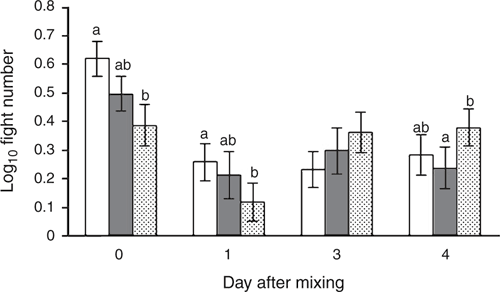Sow aggression in early gestation is decreased by greater space allowance in the first four days following mixing
E. C. Greenwood A C , K. J. Plush B , W. H. E. J. van Wettere A and P. E. Hughes BA The University of Adelaide, Roseworthy, SA 5371.
B South Australian Research and Development Institute, Roseworthy, SA 5371.
C Corresponding author. Email: emma.greenwood@adelaide.edu.au
Animal Production Science 55(12) 1504-1504 https://doi.org/10.1071/ANv55n12Ab019
Published: 11 November 2015
Group housing of sows is preferable to the use of stalls as it allows for higher social interaction and movement (Seguin et al. 2006). One disadvantage of group housing is that the mixing of sows, and therefore aggression, is unavoidable. Aggression between domestic sows is highest when sows are first introduced to each other and hierarchies are formed. The aim of this study was to determine the effect of a mixing pen involving increased space allowance at the point of mixing followed by restricted space after hierarchy formation on sow aggression. It was hypothesised that aggression at mixing would be negatively correlated to space allowance, and that space restriction after hierarchy formation would result in no detrimental effects.
The experiment used 132 multiparous, Large White x Landrace sows. Following artificial insemination sows were mixed into groups of six. Australian standards state sows must be housed at 1.4 m2/animal or greater but recent research suggests this figure is too low (Hemsworth et al. 2013), and so this experiment allowed 2 m2/sow (LOW), 4 m2/sow (MED) or 6 m2/sow (HIGH). The sows remained in these pens until d 4 after mixing, at which point all pens were equalised to 2 m2/sow. Behaviours (6 h, including eating, fighting, displacements, rest and exploration) were measured on d 0, 1, 3 and 4 relative to mixing. Data were analysed using a linear mixed model (IBM SPSS, Version 20.0; USA) with sow identification fit as a random effect, and replicate, sow parity, day of measure and treatment as fixed effects and sow as the experimental unit. Data are expressed as least squares means ± SEM. Where transformation of data occurred, the non-transformed means have been presented in the text.
The LOW group sows had a greater fight number than HIGH sows on both d 0 and 1 after mixing (LOW = 6.1, MED = 4.1, HIGH = 3.0, P < 0.05; Fig. 1). HIGH sows were involved in more fights than MED sows when the pens were decreased on d 4 (LOW = 1.9, MED = 1.7, HIGH = 2.5, P < 0.05; Fig. 1). When the change in aggression from d 3 to d 4 (after pen size was standardized) was analysed, there were no treatment effects (P > 0.05).

|
In line with previous reports (Weng et al. 1998), results from this study support the notion that providing sows with large space allowances is an effective method to reduce aggression. A novel finding of the current investigation was that space can be reduced after hierarchy formation with little impact on the number of fights per sow. As space is often cited as a limiting resource on farms, this could be an attractive methodology for producers in order to limit the effects of aggression between sows at mixing.
References
Hemsworth P, Rice M, Nash J, Morrison RS (2013) Journal of Animal Science 91, 4953–4964.| Crossref | GoogleScholarGoogle Scholar |
Seguin MJ, Barney D, Widowski TM (2006) Journal of Swine Health and Production 14, 89–96.
Weng RC, Edwards SA, English PR (1998) Applied Animal Behaviour Science 59, 307–316.
| Crossref | GoogleScholarGoogle Scholar |
Supported by Pork CRC Limited Australia and The University of Adelaide.


 ) or 6 m2/sow (HIGH
) or 6 m2/sow (HIGH  ) in group-housed sows on fight number per day/sow (on d 4 treatments were standardised to 2 m2/sow). Data are presented as log10-transformed means ± SEM; significant differences between treatments, within day, are highlighted using superscripts (a, bP < 0.01).
) in group-housed sows on fight number per day/sow (on d 4 treatments were standardised to 2 m2/sow). Data are presented as log10-transformed means ± SEM; significant differences between treatments, within day, are highlighted using superscripts (a, bP < 0.01).